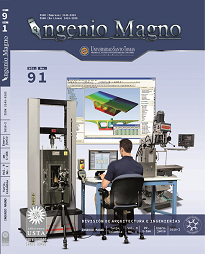Analysis theoretical-practice of efforts an by finite elements of a tension test
Main Article Content
Abstract
Downloads
Article Details
DECLARATION OF ORGINIALITY OF SUBMITTED ARTICLE
With this document, I/We certify that the article submitted for possible publication in the institutional journal INGENIO MAGNO of the Research Center Alberto Magno CIIAM of the University Santo Tomás, Tunja campus, is entirely of my(our) own writing, and is a product of my(our) direct intellectual contribution to knowledge.
All data and references to completed publications are duly identified with their respective bibliographical entries and in the citations thus highlighted. If any adjustment or correction is needed, I(we) will contact the journal authorities in advance.
Due to that stated above, I(we) declare that the entirety of the submitted material is in accordance with applicable laws regarding intellectual and industrial property, and therefore, I(we) hold myself(ourselves) responsible for any complaint related to it.
If the submitted article is published, I(we) declare that I(we) fully relinquish publishing rights of the article to the University Santo Tomás, Tunja campus. As remuneration for this relinquishment of rights, I(we) declare my(our) agreement to receive two (2) copies of the edition of the journal in which my(our) article appears.
References
ANSYS. (2016). Release 16.0. SAS IP, Inc.
Askeland, D. . (2004). La Ciencia E Ingenieeria De Los Materiales (1a. ed.). Mexico D.F: International Thonsom Editores.
ASTM. (2016). E8/E8M standard test methods for tension testing of metallic materials 1. Metal Matrix Nanocomposites, Springer,T, 42. https://doi.org/10.1520/E0008
Beer, F. P., & Johnston, E. R. (2010). Mecanica de Materiales (5a ed.). Mexico D.F: Mc Graw Hill.
Eisenberg, M. A., & Phillips, A. (1968). On nonlinear kinematic hardening. Acta Mechanica, 5(1), 113. https://doi.org/10.1007/ BF01624439HBM. (2015). El puente de Wheatstone | Galgas extensométricas |
HBM. Retrieved May 29, 2018, from https://www.hbm.com/es/7163/el-puentede-wheatstone-galgas-extensometricas/
MatWeb. (2015). AISI 4140 Steel, normalized at 870°C (1600°F), air cooled, 25 mm (1 in.) round. Retrieved May 29, 2018, from http://www.matweb.com/search/DataSheet. aspx?MatGUID=8b43d8b59e4140b88ef66 6336ba7371a
Rodrigo Hernandez. (2015). ¿Cómo instalar una galga extensiométrica? Retrieved May 29, 2018, from https://www.midebien.com/ consejos-practicos-para-medir-bien/comoinstalar-una-galga-extensiometrica
Timoshenko, S. (1999). Elementos de Resistencia de Materiales (2a. ed.). Mexico D.F: Limusa.
Salamanca Sarmiento, J. R., & Vaca rodríguez, J. S. (2017). Caracterización de un material compuesto de Tetra Pak, reforzado con polietileno de baja densidad (PEBD) y conformado en prensa de calor. Ingenio Magno, 8(1).
Tirupathi R., Ashok D. (1999). Elemento Finito en Ingeniería. Pearson Education.

